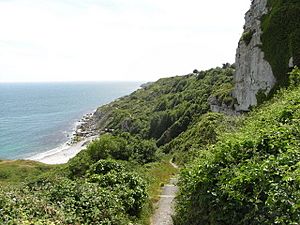Church Ope Cove facts for kids
Church Ope Cove is a small, hidden beach on the eastern side of the Isle of Portland in Dorset, southern England. It's a special part of the famous Jurassic Coast. You can find this beach near the village of Wakeham.
This beach is quite unique for Portland. It used to be sandy, but now it's covered in smooth, rounded pebbles. These pebbles are actually old quarry rocks that have been worn down by the sea. A small stream also flows across the pebbles and into the sea. This stream is one of the few active ones left on the Isle of Portland.
Contents
Discovering Church Ope Cove's Past
Church Ope Cove has a long and exciting history!
Viking Visitors and Ancient Defenses
Imagine Vikings! In 789 AD, the first recorded Viking attack in Britain happened right here on Portland's coast. Many believe it was at Church Ope Cove. To protect the area, Rufus Castle was built on the cliff above the beach. The castle you see today was built in the late 1400s.
The area around the cove was also home to Portland's very first parish church. This was St Andrew's Church, likely built by the Saxons. Its ruins are still there today.
A Governor's Grand Plans
Between 1797 and 1800, a man named John Penn built a large house called Pennsylvania Castle. He was the Governor of Portland and the grandson of William Penn, who founded Pennsylvania in America. This grand house was built on a platform overlooking the cove.
John Penn also wanted a special bath below his castle gardens. This was called John Penn's Bath. But when it was finished, the local council said he had to pay rent because it was built on common land. Penn refused to pay, so the bath was never used and was left to ruin. His servants would have had the job of carrying water up from the cove to fill it!
Smugglers, Fishers, and Wartime Secrets
Portland has a long history of smuggling, and Church Ope Cove was one of the most famous places for it. Later, into the 1900s, fishing boats still launched from the beach. You can still see an old, rusty hand winch on the beach today. It's a reminder of the fishing days.
During World War II, special defenses were built to protect the cove. Two small concrete bunkers, called pillboxes, were put in place. A minefield was also set up at the back of the cove to stop any invaders.
Enjoying the Beach Today

Church Ope Cove is one of the few beaches on Portland. It's a great spot because cliffs on three sides protect it from strong winds. After the fishing industry slowed down, the cove became a favorite place for swimming.
Today, it's still popular for many activities. You can go fishing, snorkeling, or just enjoy a swim. The clear waters also make it a great place for diving. Many shipwrecks are in the surrounding waters, which divers love to explore.
How to Get to the Cove
There are two main paths to reach Church Ope Cove.
The Main Path
The most common path follows the road past Portland Museum. It then leads you under an arch bridge that's part of Rufus Castle. From there, you go down concrete steps right to the cove. These steps were built by the local council in 1906. This was when the beach started becoming very popular for fun and relaxation. A viewpoint above these steps, looking down at the cove, is part of the coastal walking path.
The Woodland Path
The other path takes you through a small wooded area. This path goes around Pennsylvania Castle. It also passes by the ruins of St Andrew's Church, close to where John Penn's Bath used to be. This path then joins the main concrete steps about halfway down to the cove.




